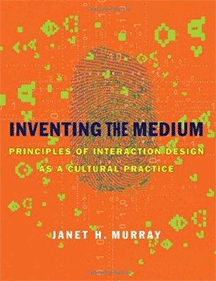By Svetlana Alpers
Our culture is going through yet another technological revolution. But some of the claims being made about digital changes seem more amazing than the revolution itself. For example, a well-known art writer and theorist recently asked what our becoming one with the pixel implies for anthropocentric models of perception. What does that mean? What is going on?
This book by a leading professor of digital media offers a practical answer. Murray began in the field of literary studies. She describes her perspective as humanistic. Her claim is that the design of digital artifacts is a cultural practice like writing a novel or making a film. The digital medium is a new medium among others. Its disparate artifacts include games, web pages, cell phones, music players and interactive TV shows all of which depend on the digital power of the computer.
As described here, the computer is encyclopedic, spatial, procedural, and participatory. Those four properties constitute its design space. The text and carefully selected illustrations address each property in turn with the aim of enabling designers, the name given creators in the new medium.
It is striking that in a culture in which everyone is continuously looking at one sort of screen or another that delivers visual artifacts or pictures to the eye, the visual is not one of the design properties named. On this account, the new medium is not about seeing, it is all about pointing. There is a huge fingerprint on the cover of the book. Is an interacting finger taking the place of the eye?
Digitalization depends on standardization. That is, as the author puts it, the antithesis of “aura” in Walter Benjamin’s sense. To remedy that, to allow for individual choice and expressivity, Murray stresses the enhancement of manual skills. Playing video games is compared to playing the piano: a grandmother is instanced who enjoys her grandson’s video games because she herself plays the piano. Adding a camera to a cell phone is not described as making pictures possible, but as making the act of visiting a place into a kind of pointing: “to claim an actual place within a social networking game as if it were a square on a Monopoly board game.”
Near the end of her book, Murray mentions Johan Huizinga, whose Homo Ludens is an iconic study of the play element in culture. It is interesting that if you turn to Huizinga’s text you find that he exempts the visual arts (what he calls the plastic arts) from the play factor. Visual artists “fix a certain aesthetic impulse in matter by means of diligent and painstaking labour. Their work has duration and is visible [my emphasis] at any moment . . . . Once finished, the work . . . will produce its effect as long as there are eyes to behold it . . . . The absence of any public action within which the work the work or art comes to life . . . seems to mean that there is no room for play.”
Visual art-making is different today. Murray’s book about interactive digital play helps explain the work of the many artists who make art for performance in galleries, museums, and other sites. It appears that seeing which takes the form of an interaction is an alternative to the anthropocentric model of perception.
Svetlana Alpers, an artist, critic and renowned art historian, is professor emerita of the history of art at the University of California, Berkeley and a visiting scholar in the Department of Fine Arts at New York University.




